Posts Tagged ‘Rechnitz Castle’
Sunday, October 25th, 2009
Book Review by Dr Erika Abcynski, Dormagen, Germany (translated by Caroline Schmitz):
‘David R L Litchfield has written a book about the Thyssen family from the founding of the Thyssen Concern to its collapse. Litchfield has assembled much interesting information about the Thyssens and thus about German capitalism per se.
As early as the founding of the first Thyssen works in 1870 August Thyssen combined greed, cleverness and sharp practice against his first business partner and brother-in-law as well as the elimination of competitors and the procurement of capital through marriage. Indeed, he concealed from his brother-in-law that he wanted to found his own rolling work in direct competition to him. The company Bechem & Keetman in Duisburg had to produce machinery exclusively for him. In the area surrounding Duisburg nobody but August Thyssen was able to buy machinery for a rolling work.
For the workers of the Thyssen works there was the rule of carrot and stick. “August’s expectations of his workers were very simple and straightforward. He expected them to abide by the ‘Reglement’, work very hard with the minimum of waste in time or materials, and produce as much as their engineer managers could get out of them…..The Meisters were expected to act as sub-contracting entrepreneurs rather than production or workshop supervisors of their respective departments”.
“The workers… remained entrapped by the Thyssens’ policy of supplying, and owning, all the worker’s needs ‘on-site’. The story, baths, canteens and lodging houses were all a man had time to need.” (quoted from David Litchfield, ‘Die Thyssen-Dynastie’). People were fired for minute transgressions. In 1928 the Thyssen-brothers Fritz and Heinrich locked out 225,000 workers for one month. Through the ownership of 67,000 workers’ lodgings, pressure could be exerted on the workforce and the government could be blackmailed through the threat of mass redundancies.
The Thyssen balance sheet for 1912 claimed the value of the Concern to be 562,153,182 Reichsmark. Before and during the First World War, there was strong collaboration between Thyssen and the Imperial government. One of August Thyssen’s friends was Hjalmar Schacht, later Hitler’s Economics Minister. Thyssens armaments production for German increased. By 1918, practically the whole enterprise produced for the war. The founding of firms in The Netherlands safeguarded Thyssen assets in case the war would be lost. Furthermore, tricks were used through the Thyssen-owned Bank voor Handel en Scheepvaart NV and assets safeguarded. Using the Hungarian citizenship of the Thyssen-son Heinrich Thyssen-Bornemisza, topped by a residency in the Netherlands, the Thyssen fortune was protected from allied confiscation, also after 1945. Heinrich Thyssen had married the daughter of the Hungarian Baron Bornemisza and had had himself adopted by his father-in-law in order to gain the title of Baron.
In 1923 there were the first contacts to Hitler. Fritz Thyssen knew about the plans for the putsch. He donated 100,000 Goldmarks for the National Socialist Party. He liked the fact that Hitler wanted to sort out the workers’ movement once and for all. At the beginning of the 1940s, Fritz Thyssen conceded that he had donated 62 million Reichsmark to the Nazi party over a 12 year period. Göring was one of his friends. In 1933 Fritz Thyssen joined the Nazi party, his wife had done so even earlier.
Tax evasion was an important business tool for the Thyssens. From 1919 to 1939 there were constant investigations by the financial authorities. In 1939 the Tax Directorate in Düsseldorf was able to prove that Fritz Thyssen had committed tax evasion and illegal foreign currency transactions, which Hitler had declared to be a capital offense. A fearful Fritz left for Switzerland on 1. September 1939, then moved to France. All his assets were placed by Göring under the trusteeship of Prussia and managed by joint friends and business partners of the two men. In other words, it was not his enmity against Hitler or any concerns about the mistreatment of Jews that led to Fritz Thyssen’s persecution, but the fact he was lining his own pockets. From the 1930s the Thyssens once again made money from armaments production, but also began simultaneously, just like August Thyssen during WWI, to safeguard their fortune, for instance in the USA and in South America. August Thyssen Hütte had nine POW-camps and seventeen camps for forced labourers. Heinrich Thyssen lived in Switzerland, led the affairs of his firms from there and continued to do business with the Nazis, but not publicly. From 1941 onwards he made his son Heini attend the meetings in Switzerland with the managers of his enterprises, which were also sometimes attended by Baron von Schröder of the Nazi bank Stein in Cologne, who was the trustee for Fritz’s confiscated industrial shares.
The most disgraceful story which members of the Thyssen family were involved in, is the murder of 200 Jews at Rechnitz Castle, where the eldest daughter of Heinrich Thyssen, Margit Batthyany, nee Thyssen-Bornemisza, lived with her husband, Count Batthyany, and high-ranking Nazis and SS-officers. During the night of 24 March 1945 the Ortsgruppen-leader Podezin, a Gestapo-official, left a party hosted by Count and Countess Batthyany with guests to shoot the Jews. The victims were 200 half-starved Jews who had been declared unfit for work. Local people said that Podezin had been in the habit of shooting Jews who were locked up in the castle cellars and that the Countess had enjoyed watching these events. After the war neither Margit nor other members of the Thyssen family wanted to know anything about this massacre and they were never prosecuted for it.
Litchfield has also assembled much information about the behaviour of the Americans and the British towards the Thyssens. For fear of the communists the Thyssens were handed back all of their fortune, works, shares and gold, despite their role in the Third Reich.
After 1945, Heinrich Thyssen transferred his role within the Thyssen Bornemisza Group to his son Heini Thyssen. But he did not much care for the Concern. Rather, he spent most of his time with sharing out his fortune. Other than that he had many relationships with glamorous, high society women and with the excesses of alcoholism. As a form of investment he bought many hundreds of paintings which were first exhibited and stored at his father’s villa in Switzerland. August Thyssen had started the art collection by buying works of Rodin, also as an investment. When Heini realised, that the maintenance of his collection was expensive, he searched for another way of handling it. Here he used all of his business acumen and various goods contacts, thus managing to sell about half of his art works to the Spanish state for 350 million dollars, payable free of tax, outside Spain, having first loaned the collection to the Spanish for 5 million dollars a year. The Spanish state met all costs for the use of the Thyssen pictures as a permanent public display.
The facts assembled in this review represent only a tiny fraction of the innumerable data painstakingly collected by Litchfield, which illustrate the greed and corruption of the Thyssens. The book is over 500 pages long and a thrilling read, the part about Heini Thyssen is somewhat too extensive.’
http://www.secarts.org/journal/index.php?show=article&id=948&PHPSESSID=ec1b0e599e946f1f299627d9346a7f4a
Tags: Adolf Hitler, Alcoholism, Armaments Production, August Thyssen, Auguste Rodin, Bank voor Handel en Scheepvaart, Bankhaus J. H. Stein, Duisburg, First World War, Forced Labour, Fritz Thyssen, Heini Thyssen, Heinrich Thyssen-Bornemisza, Hermann Göring, Kurt von Schröder, Margit Batthyany, National Socialist Party, Rechnitz Castle, Second World War, Thyssen Dynasty, Thyssen-Bornemisza Collection
Posted in The Thyssen Art Macabre, Thyssen Art, Thyssen Corporate, Thyssen Family Comments Off on ‘The Thyssen Dynasty – A Masterclass In The Unacceptable Face Of Capitalism’
Tuesday, July 14th, 2009
| I recently came across an article about August Thyssen in the summer series on famous scions of the Lower Rhine region, published by the Rheinische Post newspaper, under the promising headline ‘A Globaliser From The Start’. But it contained the sentence ‘After the World War, August Thyssen lost his foreign participations’. As somebody who has studied the Thyssens for some fourteen years now, it was the kind of throw-away remark that sharply reminded me once again of the systematic manipulation of history that has accompanied this dynasty’s personal and corporate affairs for a very long time.
If you wish to get a very basic idea of what I’m talking about, go to German Wikipedia and check out the entries for Alfred Krupp, Hugo Stinnes, Friedrich Flick and August Thyssen; all four legendary German industrialists of similar status and place in history. Krupp warrants 5 illustrated pages, Stinnes 11, Flick 10, but Thyssen barely manages to make three quarters of a page! Why should this be so? The chief publicist and archivist of ThyssenKrupp, Professor Manfred Rasch, is more than capable of producing lengthy features on the founder of the Thyssen empire at opportune moments in local publications, such as Westdeutsche Allgemeine Zeitung, which are hugely sympathetic to the image of a company that still remains one of the major employers in the Ruhr area, as well as far beyond. So why does he not ensure that extensive and accurate information is available on a more general level?
The answer is: because there are many black holes in this dynasty’s history which would be too difficult to broach. Instead, gloss-overs and simplifications have been produced over the years by the official guardians of the Thyssen legacy and reproduced by unwitting journalists and historians. But even the most consistently spin-doctored histories are eventually bound to come unravelled. This is particularly true in times of bust such as today, when money becomes scarce and people re-examine their loyalties; as long, of course, as they can enjoy the freedom of democracy rather than being forced into the shackles of authoritarian rule so admired by the likes of Ecclestone, Mosley & Co.
One reason why the Thyssens have always purported to have ‘lost everything’ in the war (for the family members tend to ‘go the extra mile’, insisting all was lost, not just the foreign assets) is to excuse their involvement in arming the German Empires of Kaiser Wilhelm II and Adolf Hitler respectively. If it were shown that they actually profited from those regimes, the Thyssens would receive far less sympathy and respect than they do when portrayed as the sacrificial victims of the conflicts, who had to rebuild their fortunes each time from scratch by the sweat of their own brows. The latter being very much the picture painted on the new website of the Thyssen-Bornemisza Museum.
In actual fact, while other industrialists were punished for their support of the Reich, the Thyssens were not. They were even compensated for their losses. After World War I, this included their Lorraine ore mines and steel works, which the French insisted they give up. Heini Thyssen himself admitted to David and myself that far from his family losing, for instance, his grand-father’s Brazilian interests after 1918, he was able to liquidate some of them in the 1970s at vast profit. Despite such good fortune, ‘foreign assets’ have always been a particularly contentious issue in the Thyssen historiography, not least because this most quintessential of German dynasties, whose name still remains one of those inextricably linked with the fatherland’s deepest sense of national prosperity, honour and pride, has continuously reaped the benefits of German industry, while simultaneously refusing to admit allegiance to the country.
While the destruction of August Thyssen’s personal files after his death in 1926 ensured the public could never realise that this supposed German patriot had in fact moved his ultimate ownership structures abroad before 1914, a more overt public relations exercise was necessary after 1945 when the magnitude of the Nazis’ criminal activity came to light. That is why official communiques began to over-engineer Heinrich Thyssen’s cosmopolitan credentials, giving assurances that he ‘had distanced himself from Germany as a young man’, that he ‘became a Hungarian in 1906’, that he ‘gained a doctorate in philosophy in London’ and that he ‘settled in Switzerland in 1932’. On closer inspection even of the official sites, however, inconsistencies soon start to appear for all of these claims.
As far as Heinrich’s nationality is concerned, ThyssenKrupp AG has for some time now resorted to the line: ‘He kept his Hungarian citizenship until he died, but nevertheless acted ‘deutsch-nationally’ at times in the 1920s and 1930s. For this vague statement to be allowed to paraphrase the activities of such an important (if shielded) figure of 20th century history is quite simply astonishing. And of course it can in no way explain how German works owned by Heinrich Thyssen were still able to claim war damages from the allied government for Germany in 1946 on the basis of Heinrich being ‘a German abroad’. The fact is: Heinrich Thyssen lived in Lugano from 1938 (not 1932! – more of this later) until his death in 1947, controlling his German interests with the help of visiting managers and this makes him somebody who acted ‘deutsch-nationally’ (if this is what you want to call it), throughout Hitler’s time in power and beyond.
Turning to Heinrich’s academic title: the assertion of a doctorate in philosophy gained in London is pure fabrication. That is why it does not appear on the German websites, where it is clear and very acceptable to people that the doctorate was gained in Germany in the field of natural sciences. It is, on the other hand, very much emphasised in Spain, where the government’s expenditure of in excess of $600 million dollars on the Thyssen-Bornemisza art collection seems to make it imperative to stress the founder’s alleged cultural and specifically non-German credentials.
Here on www.museothyssen.org, we also find echoes of Francesca Habsburg‘s recent attempts to designate August Thyssen as the true founder of the Thyssen-Bornemisza Collection (even to the extent where a recent museum web-incarnation called him ‘August Thyssen-Bornemisza’!), thereby rebranding the whole dynasty as the art collectors she would like them to be (making her fourth in a row) rather than the industrialists and bankers that they really were. But the official website of the Thyssen-Bornemisza Museum also makes another announcement: ‘We know the collection was installed at Rohoncz Castle before Heinrich abandoned Hungary in 1919’. This is particularly worrying as the comprehensive catalogue of the museum squarely confirms the documentation in the Thyssen Archives showing that the first purchase made for the collection was in 1928 (unless that too has now been re-written!)
The smoke and mirrors at Museo Thyssen continue: ‘It is through the correspondence between August Thyssen and Auguste Rodin, namely in a letter from 1911, that we can see that August’s son Heinrich had by that time started his collection’. We have researched the same letters during the writing of our book but never came across anything that would confirm this. The official line basically intimates that with his transformation into a ‘Hungarian aristocrat’ in 1905 (the real dated being 1906-07), Heinrich Thyssen had also, somehow, acquired an art collection.
What seems clear to me is that people in charge of that museum are finally realising that they have a particularly grave problem on their hands. However, not knowing what to do about it, their inability to address serious issues breeds insecurity and confusion. That’s why another sentence has been added to the website: ‘We have few details about the first years of the collection’. While I guess it would be unfairly over-stressing the point if one reminded the Spanish tax payer once again, how much money he contributed and is still paying to the Thyssen Museum, the indelible facts concerning the early history of the collection are these: the Thyssen Collection was never at Rohoncz (Rechnitz). It was only named ‘Rohoncz Collection’ by Heinrich Thyssen with the specific aim of making it sound like an Austro-Hungarian heirloom. Unbelievably, the public as well as the media have bought this fiction decade after decade.
The staff of Frankfurter Allgemeine Zeitung got equally confused in October 2007, when they ran David’s piece on Heinrich Thyssen’s daughter, Margit Batthyany, and her involvement in the murder of 180 Hungarian Jews at Rechnitz Castle in March 1945, which had been published two weeks earlier in The Independent. None of the many continental journalists and historians who subsequently busied themselves in denigrating our work, such as Anja Seeliger of Perlentaucher fame for instance, actually figured out that the reason why the two features were markedly different was not only because of overt censorship in Germany, but also because staff at FAZ saw fit to fact-check the article – the fruit of 14 years of research – against the grossly inaccurate (ThyssenKrupp AG / Museo Thyssen / Thyssen Family) Gospel According to Wikipedia, the same Wikipedia that has rejected our corrective suggestions outright.
Back at Frankfurter Allgemeine: out came 1938 as Heinrich’s settlement date in Switzerland, in went 1932 (to ensure that Heinrich’s presence in Germany after Hitler’s ascension to power could be denied). Out went the proviso that the collection was never at Rohoncz, in went the age-old phrase that it was housed there. Out came our statement that the Thyssens acquired the Erlenhof stud farm from the liquidators of the persecuted Jew, Moritz James Oppenheimer, in 1933. In went the fabrication that Heinrich Thyssen’s business empire was completely separate from August or Fritz Thyssen’s empire. While we are grateful to FAZ for publishing the feature, this type of inaccurate ‘editing’ of copy in a newspaper of such quality should be of concern to everyone.
And even today, two years after the publication of our book, the Spanish museum continues to insist that ‘Heinrich Thyssen’s enterprises were completely separate from the German steel industry’, when even ThyssenKrupp’s website has been admitting for a while now that Heinrich owned the Press- and Rolling Works Reisholz and the Oberbilker Steelworks, both plants that produced canon for Adolf.
Spain is also still holding on to the idea that Heinrich was ensconced in Switzerland from 1932 onwards, where he ‘opened the doors of his gallery to the public in 1936’. Apart from family archival evidence, Heinrich’s own war-time curator, butler and companion, Sandor Berkes, assured us that the gallery building remained unfinished until 1940 and was only opened to the public in 1948. As can be seen from the picture above, far from being locked away in his Swiss villa, in 1936 Heinrich was, amongst other things, happily socialising at the German Derby with his personal friend Hermann Göring, whom he also assisted with personal and Reich banking facilities.
With a background of such systematic disinformation, it does not come as a surprise that the personal assertions by Thyssen family members are also becoming more and more ‘retrograde’. Francesca Thyssen is quoted as explaining to the Austrian ‘News’ Magazine in November 2008 (available in hard copy version only, not online!): ‘Of course my great-uncle (Fritz) was truly deeply enmeshed in Nazi-crimes, that’s no secret. That’s why my grandfather (Heinrich) took the name Bornemisza from his wife, because he left this whole family. Because he wanted to be different and wanted to leave this family’. Or, in other words: Heinrich Thyssen foresaw the coming of the Third Reich by 27 years!…
I can understand that the various guardians of the Thyssen legacy would feel the need to rewrite the unacceptable history of this family. But I do not appreciate the fact that journalists, historians and those who should know better continue to encourage the belief in facts which they know to be untrue or should admit to be so since the publication of our book. As far as the Spanish public in particular is concerned, which is at this very moment being told by Guillermo Solana, the director of the Thyssen-Bornemisza Museum, that new gallery space is urgently needed in Malaga and Sant Feliu de Guixols because the Madrid museum is ‘running out of space’, I feel the time has come to tell him that before any more tax funds are poured into Thyssen projects, the Thyssens might be more truthful about their past and that of the collection, while the Spanish government must admit how much they have and are paying the Thyssens for the display and storage of their paintings. |
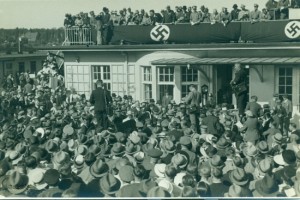 Celebrating the victory of stud farm Erlenhof's 'Nereide' at the 1936 German Derby. In the centre of the picture are (to the right) the winning horse's owner, Heinrich Thyssen (in grey top hat) and (to the left) his friend and associate Hermann Göring (in white suit) (photo: Tachyphot Berlin, copyright: David R L Litchfield) |
Tags: Anja Seeliger, August Thyssen, Francesca Habsburg, Guillermo Solana, Heinrich Thyssen, Manfred Rasch, Margit Batthyany, Oberbilker Steelworks, Press- and Rolling Works Reisholz, Rechnitz Castle, Rohoncz Collection, Thyssen-Bornemisza Museum, ThyssenKrupp
Posted in The Thyssen Art Macabre, Thyssen Art, Thyssen Corporate, Thyssen Family Comments Off on Thyssen Truth Must Come Out Before More Tax Money Goes In (by Caroline Schmitz)
Wednesday, June 24th, 2009
| After twenty months of squabbling, discussing, debating and lecturing, many Swiss, German and Austrian academics, film-makers, journalists, politicians, ‘chariticians’ and even a playwright, have still failed to come up with a plausible reason why the people of Rechnitz have allegedly remained so unforthcoming concerning the details of the massacre and burial of two hundred Hungarian Jews in the grounds of Rechnitz Castle in 1945. I never found the people of Rechnitz unforthcoming, but for those who claim they did, I can now reveal the reason for their silence.
Shortly before I issued my statement at the Elfriede Jelinek Research Centre at Vienna University on 5 May 2009, Caroline Schmitz and I met with Professor Pia Janke and her assistant, Christian Schenkermayr, for a drink at Cafe Griensteidl. We were also joined by Teresa Kovacs, a tutor and research associate at the Centre. Most importantly, unlike any of the aforementioned ‘experts’ who claim to have been studying the massacre, Teresa was born and bred in Rechnitz. Her grand-parents worked for Countess Margit Batthyany (nee Thyssen) while her father always spoke openly to her of the tragedy.
Why Teresa chose me as a messenger should have been no more of a puzzle than why Rechnitz originally chose me, via their historian, Professor Josef Hotwagner, to tell their side of the story; or what they were prepared to tell me at the time. Perhaps she also realised that I didn’t and don’t suffer from a conflict of interests. A rare qualification indeed. Particularly in Austria.
But before I decided to publish her statement, I first wanted to see if any of the opinions aired at the Eisenstadt Symposium on 16 October 2008, or the recent series of lectures and discussions at the Jelinek Research Centre would include her explanation. So far, despite the potential immediacy of the internet, nothing has been revealed concerning what was said, apart from an apparent reassurance that reports of the two symposiums would be written, printed, bound and distributed to an undefined readership at some indeterminate time in the future.
When I read a recent article by the Austrian writer Martin Pollack in the Swiss newspaper Neue Zürcher Zeitung, once again questioning the motivation of the people of Rechnitz ‘withholding information’, I was somewhat surprised that a man, who had found it so difficult to reveal his own family history, should be asking such a question, rather than supplying the answer. But it also occurred to me that maybe it wasn’t so much the people of the town who were secretive, as the plethora of ‘experts’, who had proved so reluctant to accept the truth.
I believe the reason why Ms Kovacs had decided to tell me what everyone in Rechnitz knows, is because she wants the public to know now. Not in another sixty years’ time.
So this is what she told me that afternoon at Cafe Griensteidl:
‘While Countess Batthyany was in Rechnitz, there was always money around. Her name was never spoken of in connection with the atrocity, only ever in connection with wealth and the beautiful Castle. Basically, the Countess continued to give money and plots of land away to people in Rechnitz right until the 1980s, practically until the day she died’.
It was so wonderfully clear, simple and obvious, it really shouldn’t have come as such a surprise to me. I already knew that Margit’s father, ‘Baron’ Heinrich Thyssen-Bornemisza, had ‘primed the pump’ by bequeathing a plot of land, a specific plot of land, to his Rechnitz forester.
The Castle had always been the very heart and soul of Rechnitz. Without it, the town should have died, but the Castle’s continued existence would have been a memorial to the atrocity. Now, while Margit Thyssen’s money ensured the town’s survival, the ghost of the Castle continues to haunt the town.
As Teresa put it so beautifully: ‘The Castle has gone….but it is still there!’ Elfriede Jelinek could not have put it better. |
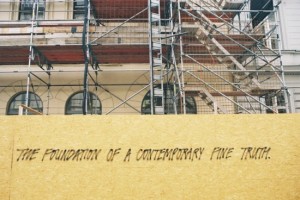 Vienna, Burgring, 2009 |
Tags: Elfriede Jelinek Research Centre, Heinrich Thyssen-Bornemisza, Josef Hotwagner, Margit Batthyany, Margit Thyssen, Martin Pollack, Pia Janke, Rechnitz Castle, Rechnitz Massacre, Teresa Kovacs
Posted in The Thyssen Art Macabre, Thyssen Family Comments Off on Reason For Rechnitz Silence Revealed
Friday, May 8th, 2009
| During December 2008, I was invited by the Elfriede Jelinek Research Centre at the University of Vienna to take part in a discussion concerning her play ‘Rechnitz (Der Würgeengel)’ to take place in May 2009. Some four weeks prior to the event, I discovered one of the sponsors of the series of lectures and discussions under the title ‘Endless Innocence’ was to be Francesca Habsburg, nee Thyssen, in the form of her art foundation Thyssen-Bornemisza Art Contemporary (T-B A21). My introductory statement which I gave on the evening of 5 May in Vienna was largely in response to this situation. It read as follows:
‘I would like to say how gratified I am to have played such a major part in persuading Francesca Thyssen to accept, as part of her financial inheritance, some responsibility for her family’s behaviour. I believe this to be manifest in her sponsoring of this event.
However, I would have been even more gratified if she had made an apologetic admission, as opposed to a financial contribution, for being that the Thyssens were sponsors of Rechnitz Castle and the Countess (and I do have documentary evidence of that fact with me tonight), I consider there to be something obscenely ironic about the fact that we are all sitting here, 64 years later, discussing the Rechnitz Massacre, or a play by Elfriede Jelinek, which includes the massacre, while yet again being sponsored by The Thyssens in the form of Francesca’s art foundation.
I am also forced to question how, as long as any doubt remains concerning the extent of the Thyssens’ involvement in the Rechnitz Massacre, Vienna University can accept her money while claiming impartiality.
Unfortunately, this conflict of interest is not a unique situation in the academic world, particularly in the case of Wolfgang Benz, head of Anti-Semitism Research at the Technical University of Berlin, and Richard Evans, Chairman of the Faculty of History at Cambridge University, who have both attempted to discredit my writing in Frankfurter Allgemeine Zeitung and my book, ‘The Thyssen Art Macabre’, published in Germany under the title ‘Die Thyssen-Dynastie’, while accepting funding from the Fritz Thyssen Stiftung.
I am sad to say that I consider this type of arrangement brings into question the credibility of academic historians.
I now have another question. If Countess Margit Batthyany, nee Thyssen, sponsored the murder of 200 Hungarian Jews as after-dinner entertainment and possibly even played an active role in their murder, and then Elfriede Jelinek writes a play involving the atrocity, which can also be characterised as entertainment, albeit intellectual entertainment, but which I’m sure everyone here considers a work of art, where does that leave the killing of the Jews?
As I hope and believe is obvious from my article in Frankfurter Allgemeine Zeitung and my book ‘Die Thyssen-Dynastie’, I consider it a crime against humanity. And no amount of art sponsorship, intellectual smoke screens or academic denial is ever going to alter that.’
I was subsequently informed that Francesca had promised the university to make a public statement, but had failed to do so, despite numerous reminders, prior to her departure to her house in Jamaica.
http://www.jamaica-gleaner.com/gleaner/20090515/social/social3.html
(For the German version of my statement, please go to ‘Events’). |
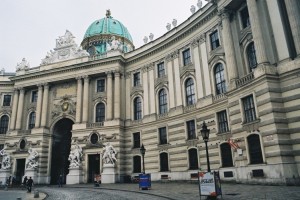 Vienna University, Elfriede Jelinek Research Centre 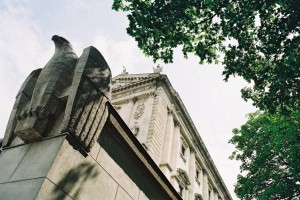 The Reich and the Habsburgs working together in public & private partnership 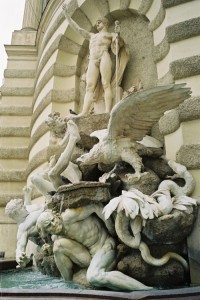 Professor Janke of the Elfriede Jelinek Research Centre still experiencing difficulties appreciating what constitutes freedom of speech |
Tags: Elfriede Jelinek, Elfriede Jelinek Research Centre, Francesca Habsburg, Francesca Thyssen, Fritz Thyssen Stiftung, Margit Batthyany, Rechnitz Castle, Rechnitz Massacre, Richard Evans, Thyssen-Bornemisza Art Contemporary, Wolfgang Benz
Posted in The Thyssen Art Macabre, Thyssen Corporate, Thyssen Family Comments Off on Vienna University’s Impartiality In Question
|






